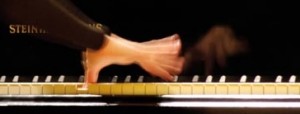Scale playing is one of the first things that a child is taught at the piano. 1 2 3 1 2 3 4 5 would perhaps be the right hand fingering for most of the beginners (having the little thumb crossing under the third finger as we play the scale). And this set of fingering, usually combines with the popular C major scale - despite the fact that it is the most difficult scale to master. The reason is that, not only C major scale itself does not have any black notes on the keyboard (which makes the scales awkward to play), but also the emphasis on finger legato in this scale position.
The Polish pianist and composer, Frédéric Chopin was well known for his cantabile legato playing. Friederike Müller (a pupil of Chopin) once recalled, ‘Chopin’s playing was always noble and beautiful; his tones sang, whether in full forte or softest piano. He took infinite pains to teach his pupils this legato, cantabile style of playing. However, his most severe criticism (for his pupil) was “He/she does not know how to join two notes together!” Although Chopin emphasis much on legato playing, but as we know from many of his pupils, what more important is the hand position. Chopin recognized the following hand position as a ‘natural hand shape’ (Example 1a & 1b).
Example 1a: Natural Hand Shape
Example 1b: Natural Hand Shape on keyboard
One may have realized those few notes in Example 1a are part of a scale. And indeed, the first scale that Chopin introduced to his pupils was B major. If one tries to place their fingers on these notes (as in Example 1b), they will find it much more comfortable than the C major position (Example 2). This is simply because our second, third and fourth fingers are longer than the other two and therefore, those three fingers on the black notes would have accommodate it more naturally.
Example 2: C Major Hand Position
The importance of hands position is stressed by several other pianists, including Ludwig van Beethoven. His pupil, Carl Czerny wrote in his ‘Memoirs’ about Beethoven; ‘In the first lesson, Beethoven had me concentrate exclusively on scales in all the keys, showed me the only correct position of the hands and fingers (unknown as yet to most players at that time), and especially the use of the thumb – rules whose value I came to appreciate only much later.’
Thus, teachers should think more carefully which scale they should introduce to the beginners at the beginning. Although the awkward moment of crossing the thumb under the third finger remains unsolved at this stage, but the ‘Memoirs’ by Czerny certainly contains a big clue. Undoubtedly, finger legato is a basic part of piano technique and Beethoven considered that as one of the most important elements of piano playing. Nevertheless, this fundamental practice is not as useful for some pianists as piano teachers think. A pupil of the late Dinu Lipatti once remarked the following comment by Lipatti, ‘You know, it has been at least ten years since I crossed my thumb under the third finger.’ One may wonder how then, did Lipatti connect the notes, if he didn’t use the ‘finger legato’?
The ‘Klavierübung’ (Piano Tutorial) written by the Italian pianist and composer, Ferruccio Busoni hinted another fine example of ‘another type’ of legato (Example 3).
Example 3: first part of the six tutorials and preludes in Klavierübung
In the example above, the fingering that Busoni indicated does not mean to connect the whole scale by using finger legato. What more important is the shifting motion, it becomes relatively easy when it is played with the given tempo - Presto. Some pianists find wiggling their thumb into an awkward position moves the hand into an inconvenient angle. Therefore, what Busoni suggested here is to keep the hands at a steady angle and displace the arms quickly to the right (ascending) when shifting from the fifth finger to the thumb and to the left when descending.
Everything of course, depends on the shape of the hand but certainly there is no such thing as an ideal pianist’s hand or ‘the only’ type of legato!
©Blanc Wan 2013
 Back to List
Back to List